University Data Analysis Report: Facebook Usage and User Behavior
VerifiedAdded on 2020/05/28
|16
|1836
|94
Report
AI Summary
This report presents a data analysis of Facebook usage, based on a questionnaire distributed to a focus group. The analysis covers various quantitative variables, including the number of Facebook friends, groups, notifications, and time spent on the platform. Statistical measures such as mean, median, standard deviation, and correlation coefficients are calculated and visualized using bar plots, box plots, scatter plots, and radar plots. Qualitative variables, such as the time of day Facebook is mostly used and frequency of status updates, are also examined using histograms and pie charts. The study reveals insights into user behavior, highlighting trends in Facebook usage and the potential for addiction. The report concludes with a summary of the findings and discusses the implications of the data analysis, including the correlation between friend count and time spent on Facebook, and the perception of Facebook reaching a stagnation point. The report includes references to relevant research in the field.
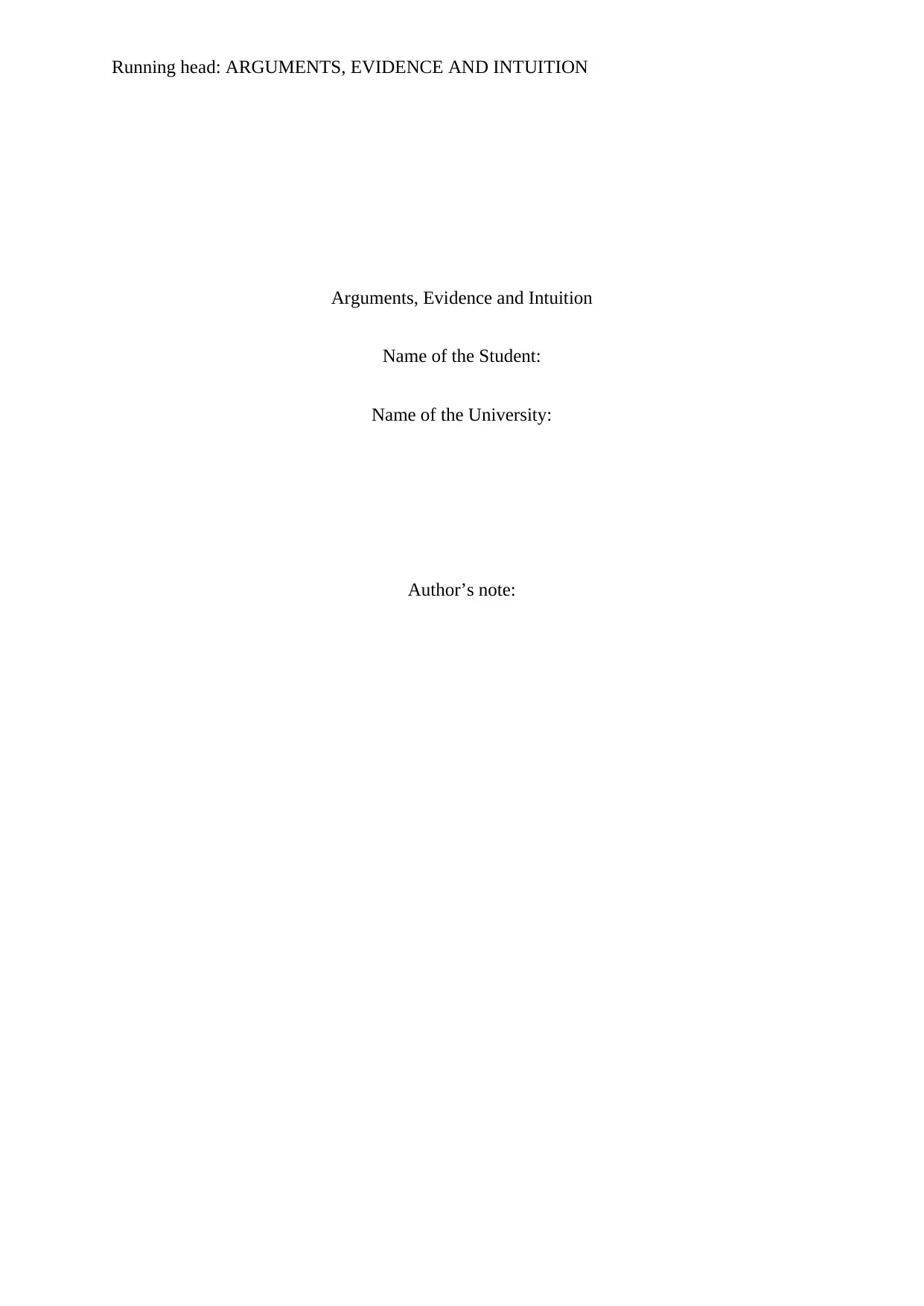
Running head: ARGUMENTS, EVIDENCE AND INTUITION
Arguments, Evidence and Intuition
Name of the Student:
Name of the University:
Author’s note:
Arguments, Evidence and Intuition
Name of the Student:
Name of the University:
Author’s note:
Paraphrase This Document
Need a fresh take? Get an instant paraphrase of this document with our AI Paraphraser
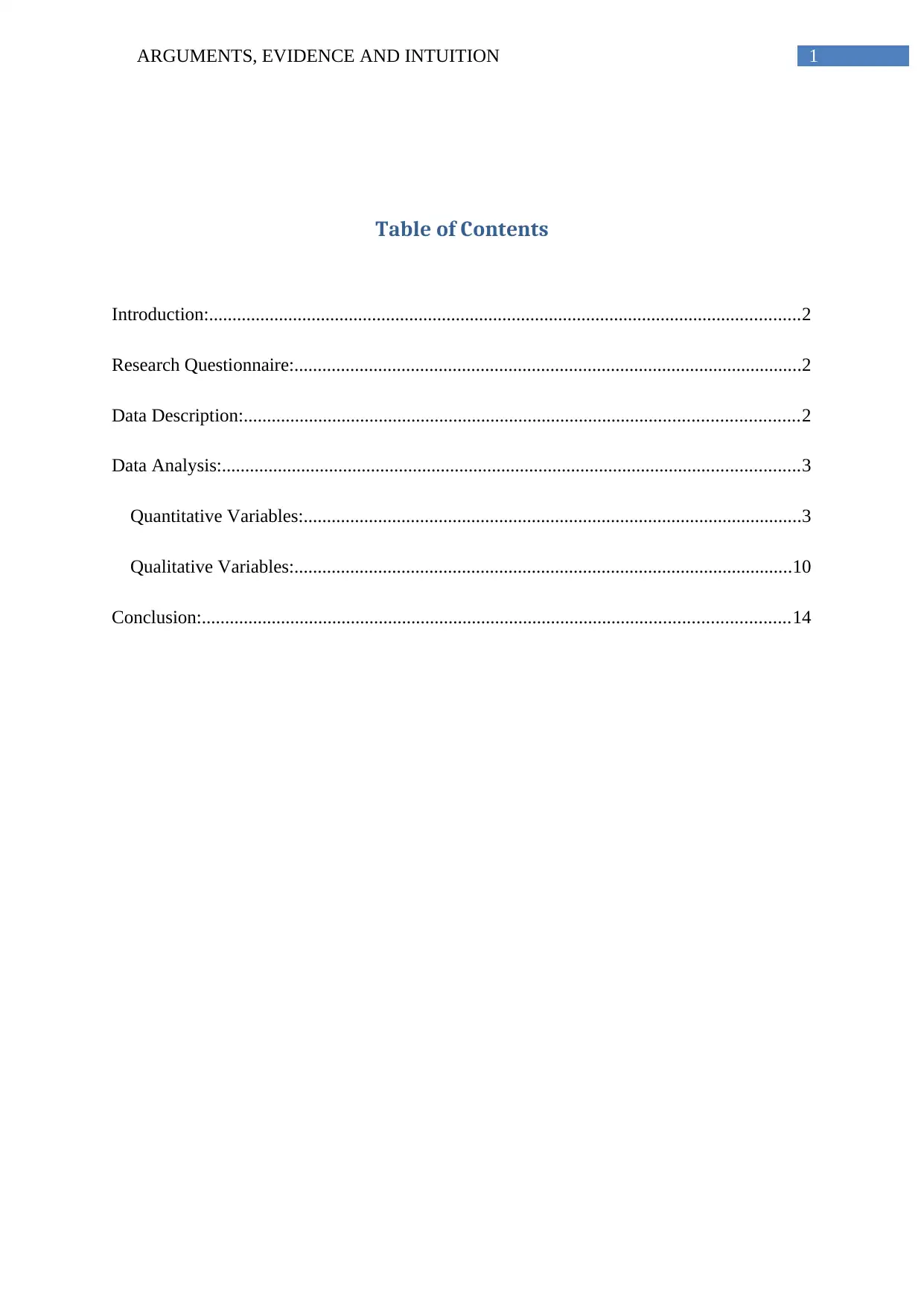
1ARGUMENTS, EVIDENCE AND INTUITION
Table of Contents
Introduction:...............................................................................................................................2
Research Questionnaire:.............................................................................................................2
Data Description:.......................................................................................................................2
Data Analysis:............................................................................................................................3
Quantitative Variables:...........................................................................................................3
Qualitative Variables:...........................................................................................................10
Conclusion:..............................................................................................................................14
Table of Contents
Introduction:...............................................................................................................................2
Research Questionnaire:.............................................................................................................2
Data Description:.......................................................................................................................2
Data Analysis:............................................................................................................................3
Quantitative Variables:...........................................................................................................3
Qualitative Variables:...........................................................................................................10
Conclusion:..............................................................................................................................14

2ARGUMENTS, EVIDENCE AND INTUITION
Introduction:
Facebook is a social website that is being significantly vast and popular year after
year. In last five years, Facebook reached a landmark of 1.8 billion monthly users. From kids
to aged persons, Facebook has become a very well known social website. The report and data
analysis logically and statistically attempts to focus on the current and future phenomenon of
this free-user social media. The addiction of Facebook is a common issue now-days (Griffiths
2012). The identifications of Peoples’ behaviours towards Facebook are going to be
discussed in this report.
Research Questionnaire:
The data set collected in the questionnaire method on the topic of use of facebook. The
questionnaire included some basic questions and their answers. These are –
1. How many Facebook fiends do you have?
2. How many Facebook groups are you associated with?
3. How many notifications do you get in a day?
4. At what time of the day, do you use Facebook most?
5. How often do you update your Facebook status?
6. How many minutes do you spend with Facebook per day?
7. Do you use Facebook more than what you did last a year ago?
8. Do you think Facebook has reached stagnation point? If yes why?
The questionnaire was circulated via email to the respondents. The total 69 responses
were granted and among them 50 responses were tabulated after eliminating some
unanswered responses and missing numerical values (Sudman and Bradburn 1983).
Introduction:
Facebook is a social website that is being significantly vast and popular year after
year. In last five years, Facebook reached a landmark of 1.8 billion monthly users. From kids
to aged persons, Facebook has become a very well known social website. The report and data
analysis logically and statistically attempts to focus on the current and future phenomenon of
this free-user social media. The addiction of Facebook is a common issue now-days (Griffiths
2012). The identifications of Peoples’ behaviours towards Facebook are going to be
discussed in this report.
Research Questionnaire:
The data set collected in the questionnaire method on the topic of use of facebook. The
questionnaire included some basic questions and their answers. These are –
1. How many Facebook fiends do you have?
2. How many Facebook groups are you associated with?
3. How many notifications do you get in a day?
4. At what time of the day, do you use Facebook most?
5. How often do you update your Facebook status?
6. How many minutes do you spend with Facebook per day?
7. Do you use Facebook more than what you did last a year ago?
8. Do you think Facebook has reached stagnation point? If yes why?
The questionnaire was circulated via email to the respondents. The total 69 responses
were granted and among them 50 responses were tabulated after eliminating some
unanswered responses and missing numerical values (Sudman and Bradburn 1983).
⊘ This is a preview!⊘
Do you want full access?
Subscribe today to unlock all pages.

Trusted by 1+ million students worldwide
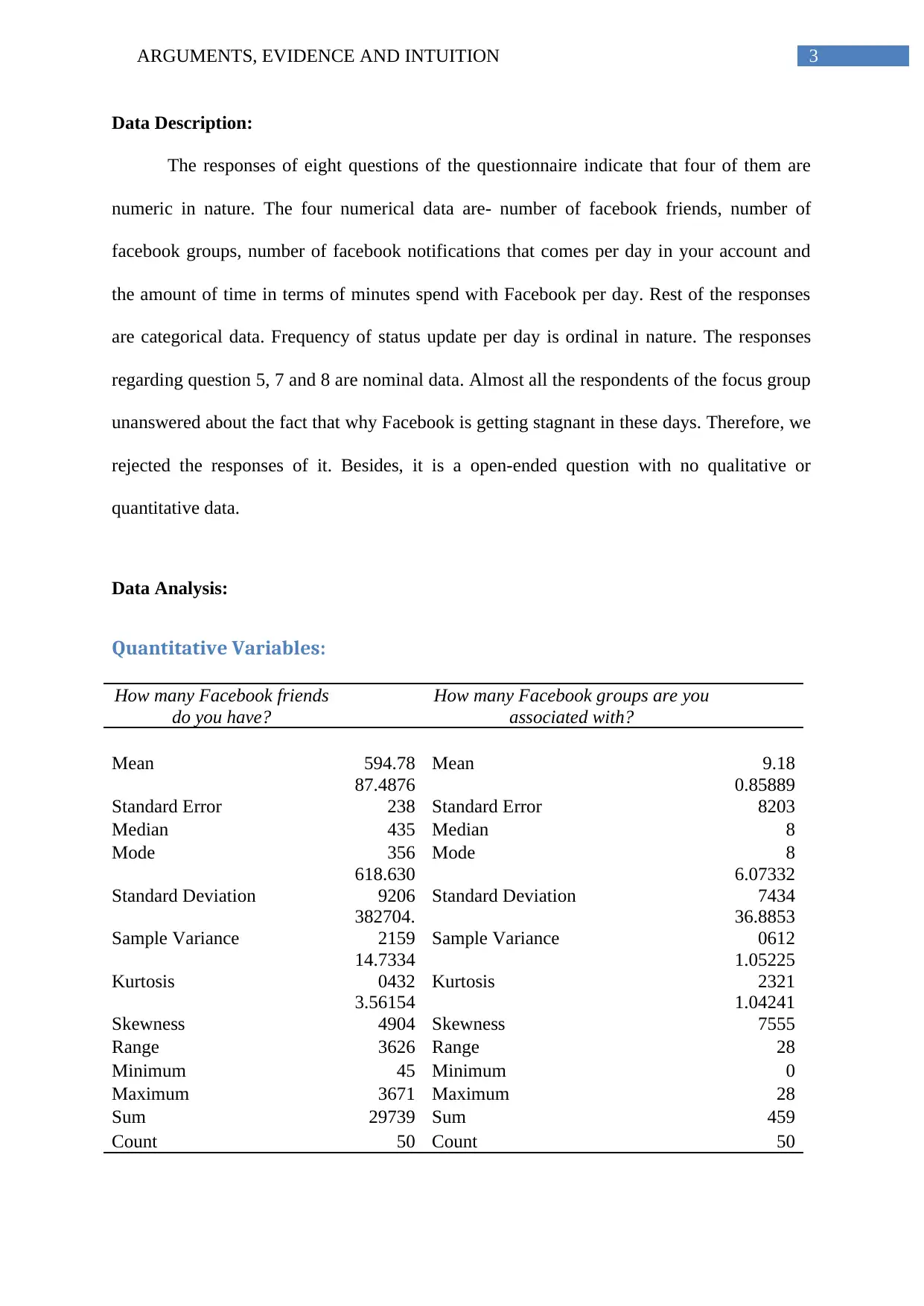
3ARGUMENTS, EVIDENCE AND INTUITION
Data Description:
The responses of eight questions of the questionnaire indicate that four of them are
numeric in nature. The four numerical data are- number of facebook friends, number of
facebook groups, number of facebook notifications that comes per day in your account and
the amount of time in terms of minutes spend with Facebook per day. Rest of the responses
are categorical data. Frequency of status update per day is ordinal in nature. The responses
regarding question 5, 7 and 8 are nominal data. Almost all the respondents of the focus group
unanswered about the fact that why Facebook is getting stagnant in these days. Therefore, we
rejected the responses of it. Besides, it is a open-ended question with no qualitative or
quantitative data.
Data Analysis:
Quantitative Variables:
How many Facebook friends
do you have?
How many Facebook groups are you
associated with?
Mean 594.78 Mean 9.18
Standard Error
87.4876
238 Standard Error
0.85889
8203
Median 435 Median 8
Mode 356 Mode 8
Standard Deviation
618.630
9206 Standard Deviation
6.07332
7434
Sample Variance
382704.
2159 Sample Variance
36.8853
0612
Kurtosis
14.7334
0432 Kurtosis
1.05225
2321
Skewness
3.56154
4904 Skewness
1.04241
7555
Range 3626 Range 28
Minimum 45 Minimum 0
Maximum 3671 Maximum 28
Sum 29739 Sum 459
Count 50 Count 50
Data Description:
The responses of eight questions of the questionnaire indicate that four of them are
numeric in nature. The four numerical data are- number of facebook friends, number of
facebook groups, number of facebook notifications that comes per day in your account and
the amount of time in terms of minutes spend with Facebook per day. Rest of the responses
are categorical data. Frequency of status update per day is ordinal in nature. The responses
regarding question 5, 7 and 8 are nominal data. Almost all the respondents of the focus group
unanswered about the fact that why Facebook is getting stagnant in these days. Therefore, we
rejected the responses of it. Besides, it is a open-ended question with no qualitative or
quantitative data.
Data Analysis:
Quantitative Variables:
How many Facebook friends
do you have?
How many Facebook groups are you
associated with?
Mean 594.78 Mean 9.18
Standard Error
87.4876
238 Standard Error
0.85889
8203
Median 435 Median 8
Mode 356 Mode 8
Standard Deviation
618.630
9206 Standard Deviation
6.07332
7434
Sample Variance
382704.
2159 Sample Variance
36.8853
0612
Kurtosis
14.7334
0432 Kurtosis
1.05225
2321
Skewness
3.56154
4904 Skewness
1.04241
7555
Range 3626 Range 28
Minimum 45 Minimum 0
Maximum 3671 Maximum 28
Sum 29739 Sum 459
Count 50 Count 50
Paraphrase This Document
Need a fresh take? Get an instant paraphrase of this document with our AI Paraphraser
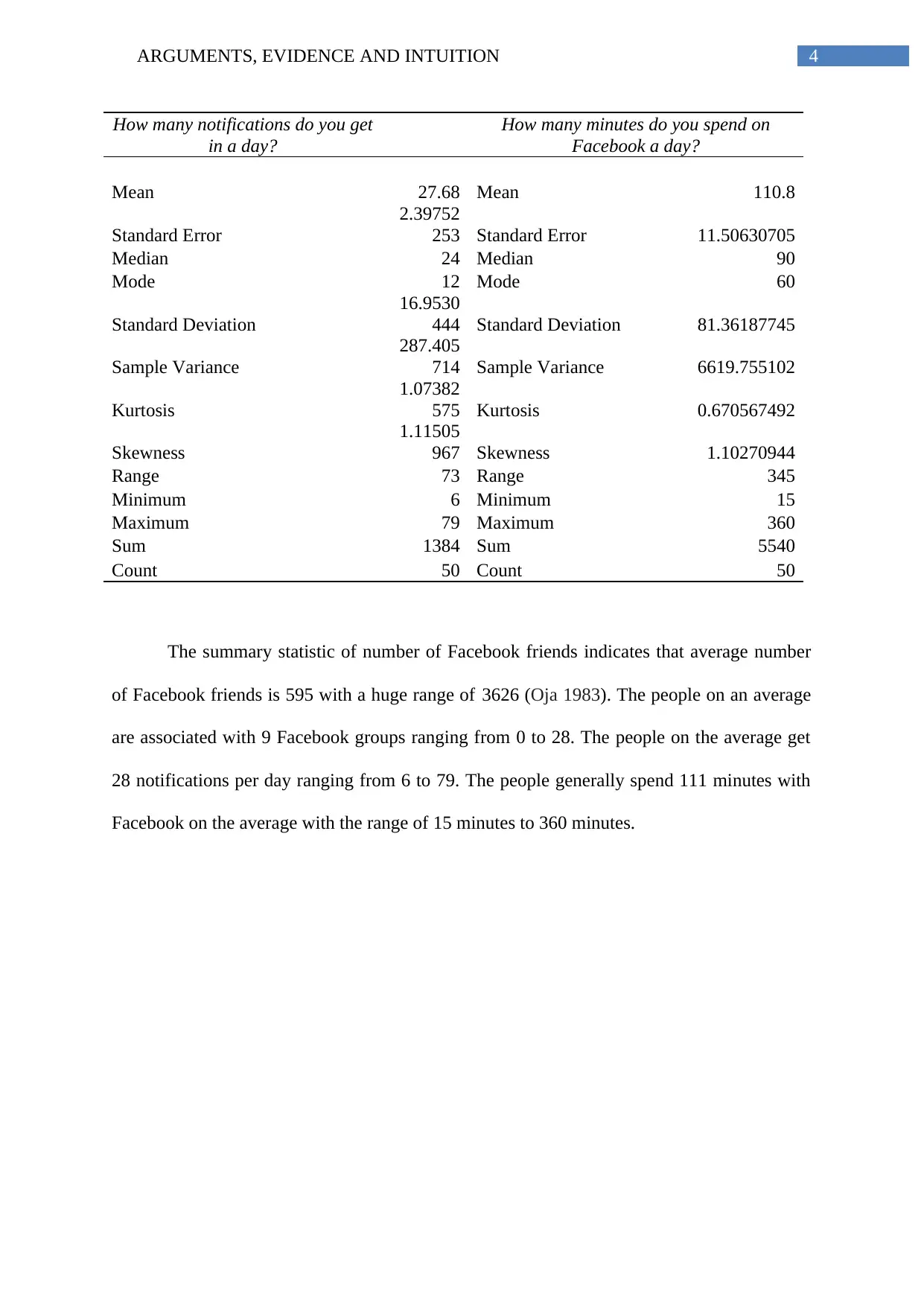
4ARGUMENTS, EVIDENCE AND INTUITION
How many notifications do you get
in a day?
How many minutes do you spend on
Facebook a day?
Mean 27.68 Mean 110.8
Standard Error
2.39752
253 Standard Error 11.50630705
Median 24 Median 90
Mode 12 Mode 60
Standard Deviation
16.9530
444 Standard Deviation 81.36187745
Sample Variance
287.405
714 Sample Variance 6619.755102
Kurtosis
1.07382
575 Kurtosis 0.670567492
Skewness
1.11505
967 Skewness 1.10270944
Range 73 Range 345
Minimum 6 Minimum 15
Maximum 79 Maximum 360
Sum 1384 Sum 5540
Count 50 Count 50
The summary statistic of number of Facebook friends indicates that average number
of Facebook friends is 595 with a huge range of 3626 (Oja 1983). The people on an average
are associated with 9 Facebook groups ranging from 0 to 28. The people on the average get
28 notifications per day ranging from 6 to 79. The people generally spend 111 minutes with
Facebook on the average with the range of 15 minutes to 360 minutes.
How many notifications do you get
in a day?
How many minutes do you spend on
Facebook a day?
Mean 27.68 Mean 110.8
Standard Error
2.39752
253 Standard Error 11.50630705
Median 24 Median 90
Mode 12 Mode 60
Standard Deviation
16.9530
444 Standard Deviation 81.36187745
Sample Variance
287.405
714 Sample Variance 6619.755102
Kurtosis
1.07382
575 Kurtosis 0.670567492
Skewness
1.11505
967 Skewness 1.10270944
Range 73 Range 345
Minimum 6 Minimum 15
Maximum 79 Maximum 360
Sum 1384 Sum 5540
Count 50 Count 50
The summary statistic of number of Facebook friends indicates that average number
of Facebook friends is 595 with a huge range of 3626 (Oja 1983). The people on an average
are associated with 9 Facebook groups ranging from 0 to 28. The people on the average get
28 notifications per day ranging from 6 to 79. The people generally spend 111 minutes with
Facebook on the average with the range of 15 minutes to 360 minutes.
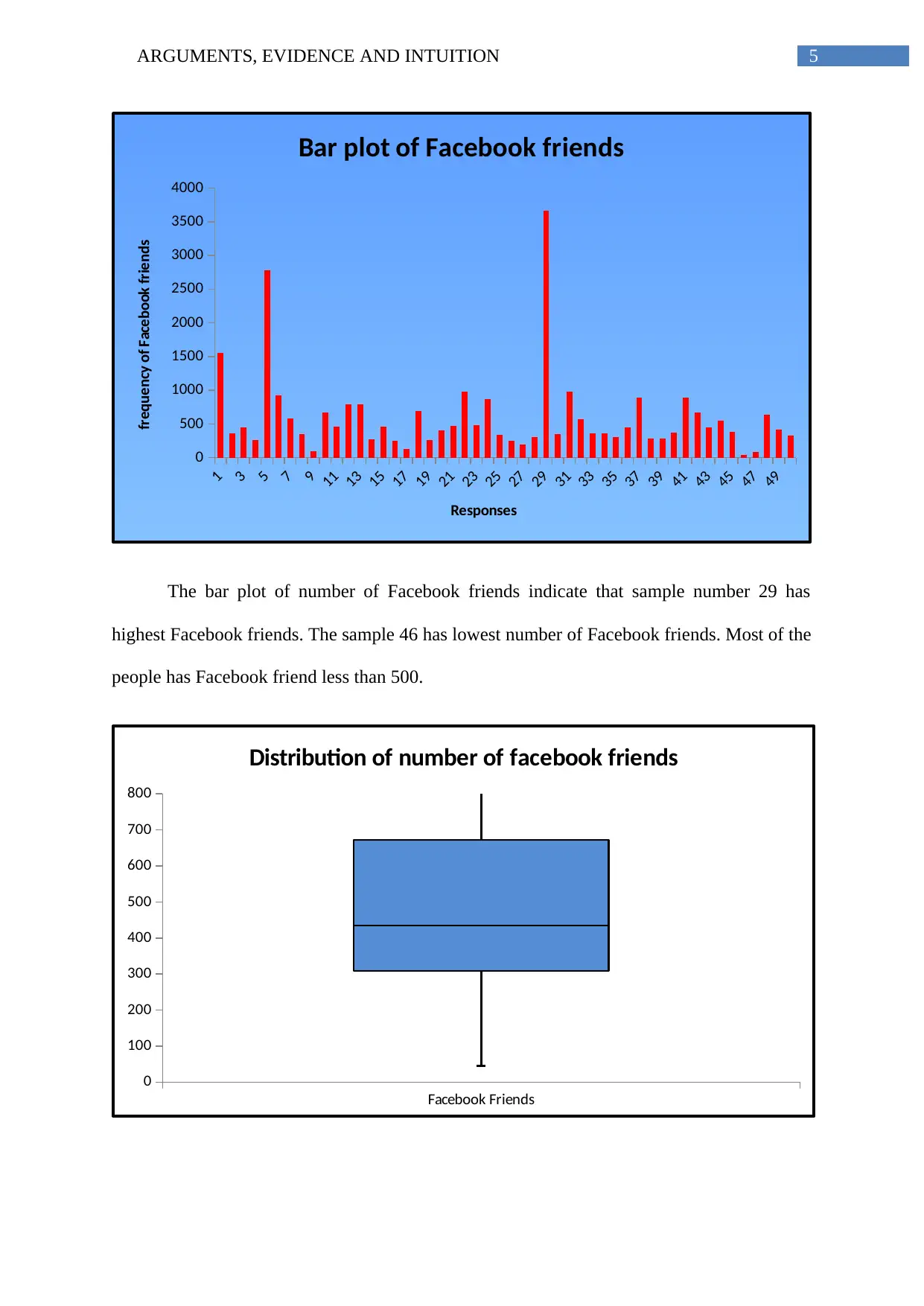
5ARGUMENTS, EVIDENCE AND INTUITION
1
3
5
7
9
11
13
15
17
19
21
23
25
27
29
31
33
35
37
39
41
43
45
47
49
0
500
1000
1500
2000
2500
3000
3500
4000
Bar plot of Facebook friends
Responses
frequency of Facebook friends
The bar plot of number of Facebook friends indicate that sample number 29 has
highest Facebook friends. The sample 46 has lowest number of Facebook friends. Most of the
people has Facebook friend less than 500.
Facebook Friends
0
100
200
300
400
500
600
700
800
Distribution of number of facebook friends
1
3
5
7
9
11
13
15
17
19
21
23
25
27
29
31
33
35
37
39
41
43
45
47
49
0
500
1000
1500
2000
2500
3000
3500
4000
Bar plot of Facebook friends
Responses
frequency of Facebook friends
The bar plot of number of Facebook friends indicate that sample number 29 has
highest Facebook friends. The sample 46 has lowest number of Facebook friends. Most of the
people has Facebook friend less than 500.
Facebook Friends
0
100
200
300
400
500
600
700
800
Distribution of number of facebook friends
⊘ This is a preview!⊘
Do you want full access?
Subscribe today to unlock all pages.

Trusted by 1+ million students worldwide
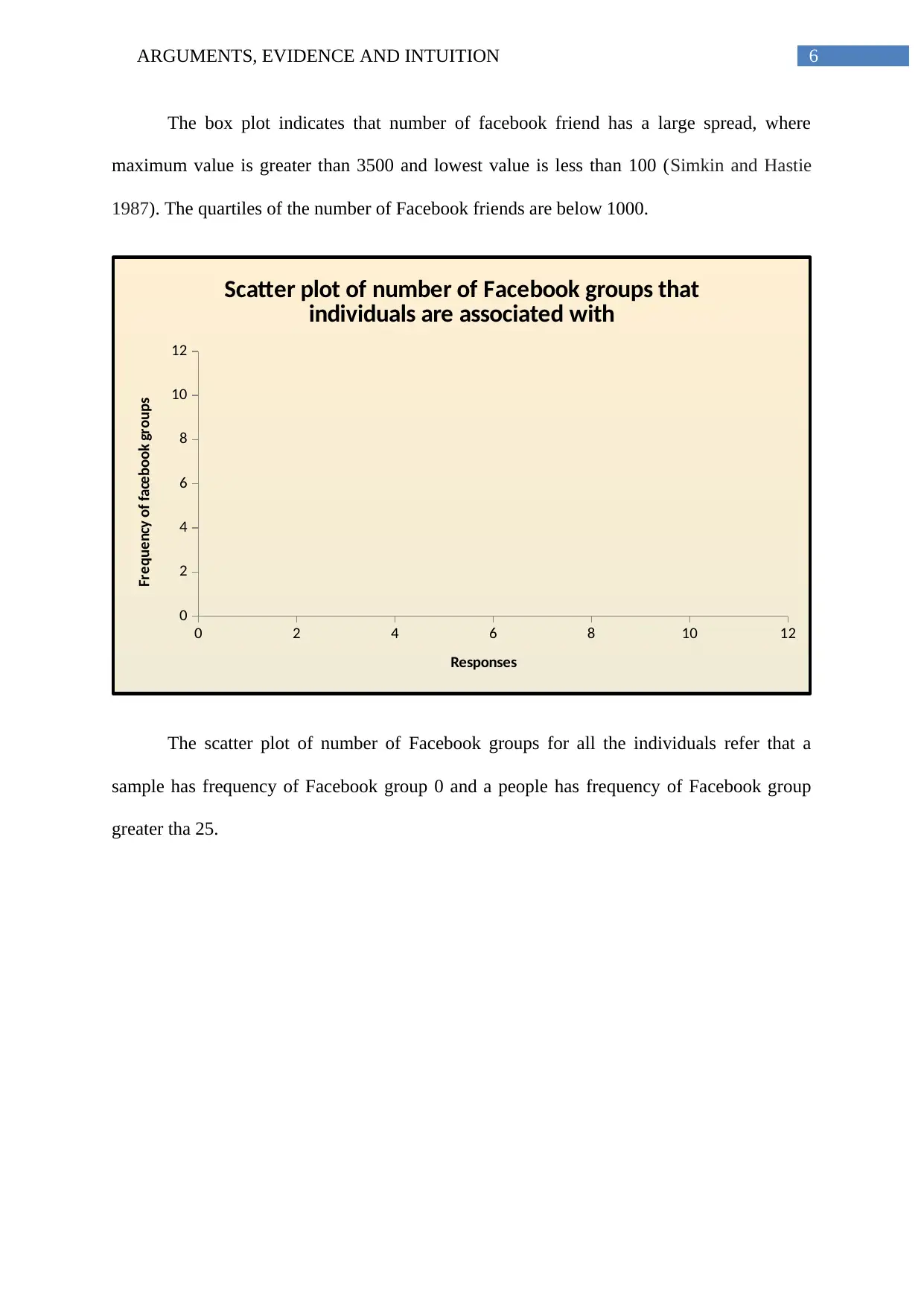
6ARGUMENTS, EVIDENCE AND INTUITION
The box plot indicates that number of facebook friend has a large spread, where
maximum value is greater than 3500 and lowest value is less than 100 (Simkin and Hastie
1987). The quartiles of the number of Facebook friends are below 1000.
0 2 4 6 8 10 12
0
2
4
6
8
10
12
Scatter plot of number of Facebook groups that
individuals are associated with
Responses
Frequency of facebook groups
The scatter plot of number of Facebook groups for all the individuals refer that a
sample has frequency of Facebook group 0 and a people has frequency of Facebook group
greater tha 25.
The box plot indicates that number of facebook friend has a large spread, where
maximum value is greater than 3500 and lowest value is less than 100 (Simkin and Hastie
1987). The quartiles of the number of Facebook friends are below 1000.
0 2 4 6 8 10 12
0
2
4
6
8
10
12
Scatter plot of number of Facebook groups that
individuals are associated with
Responses
Frequency of facebook groups
The scatter plot of number of Facebook groups for all the individuals refer that a
sample has frequency of Facebook group 0 and a people has frequency of Facebook group
greater tha 25.
Paraphrase This Document
Need a fresh take? Get an instant paraphrase of this document with our AI Paraphraser
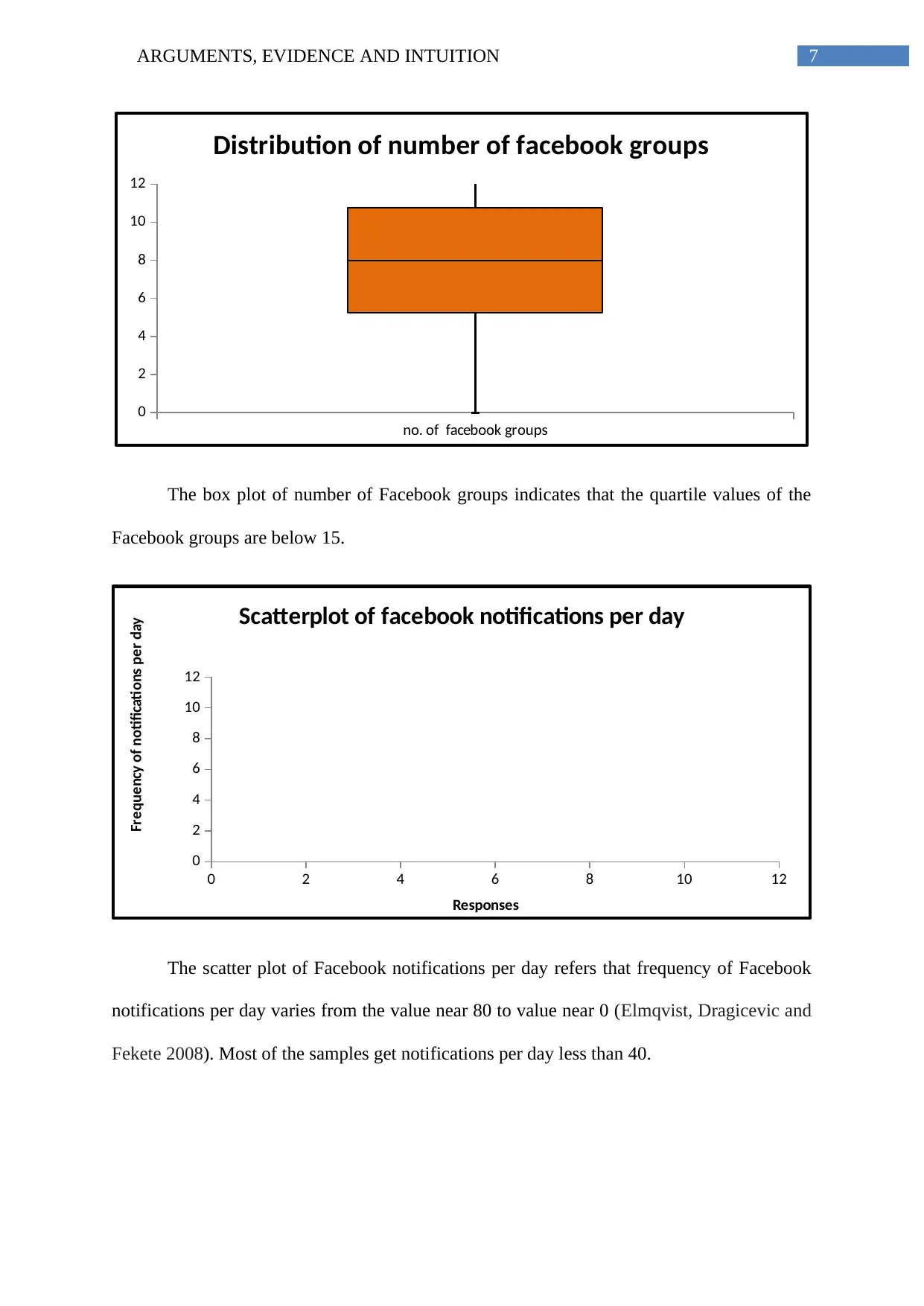
7ARGUMENTS, EVIDENCE AND INTUITION
no. of facebook groups
0
2
4
6
8
10
12
Distribution of number of facebook groups
The box plot of number of Facebook groups indicates that the quartile values of the
Facebook groups are below 15.
0 2 4 6 8 10 12
0
2
4
6
8
10
12
Scatterplot of facebook notifications per day
Responses
Frequency of notifications per day
The scatter plot of Facebook notifications per day refers that frequency of Facebook
notifications per day varies from the value near 80 to value near 0 (Elmqvist, Dragicevic and
Fekete 2008). Most of the samples get notifications per day less than 40.
no. of facebook groups
0
2
4
6
8
10
12
Distribution of number of facebook groups
The box plot of number of Facebook groups indicates that the quartile values of the
Facebook groups are below 15.
0 2 4 6 8 10 12
0
2
4
6
8
10
12
Scatterplot of facebook notifications per day
Responses
Frequency of notifications per day
The scatter plot of Facebook notifications per day refers that frequency of Facebook
notifications per day varies from the value near 80 to value near 0 (Elmqvist, Dragicevic and
Fekete 2008). Most of the samples get notifications per day less than 40.
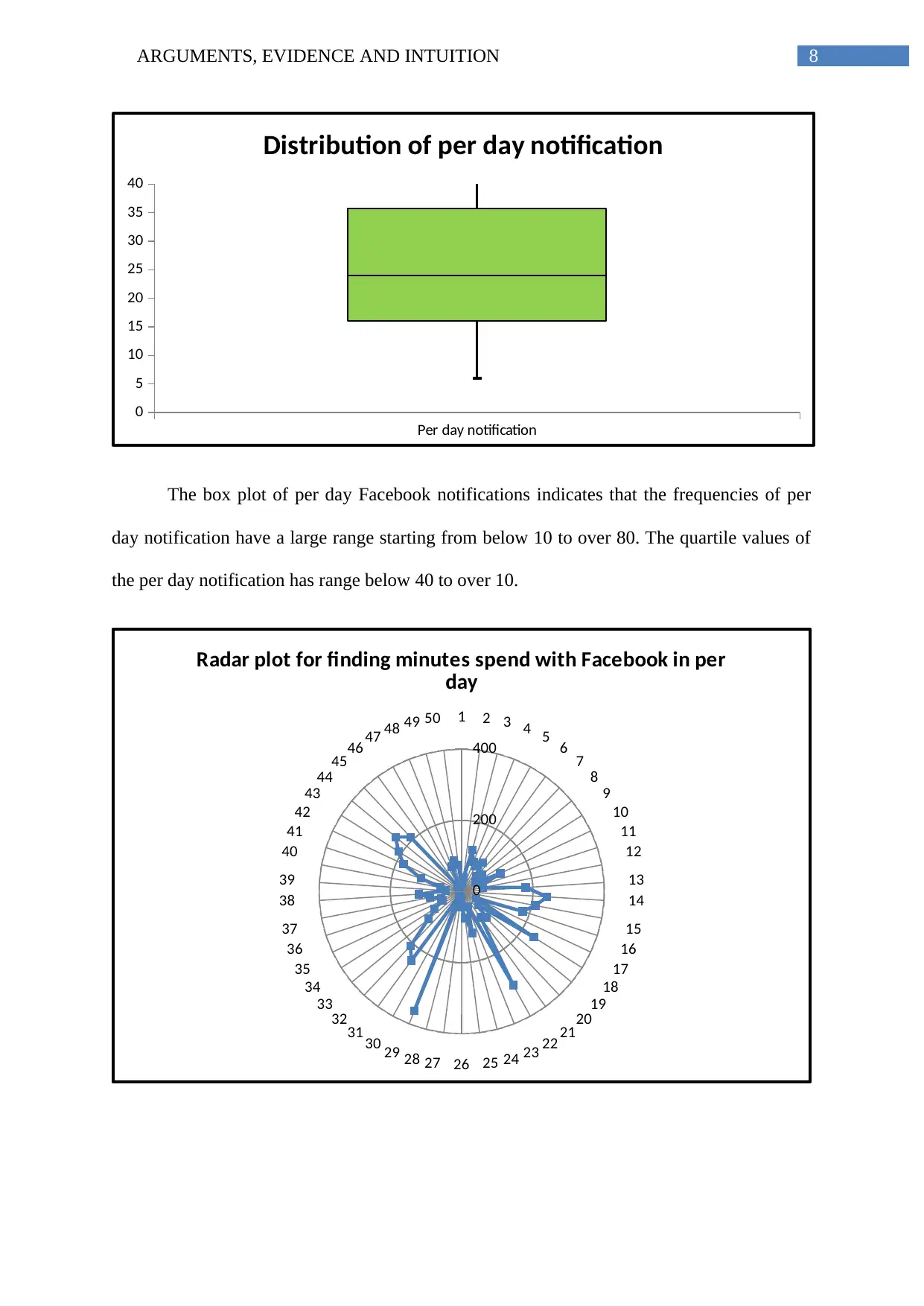
8ARGUMENTS, EVIDENCE AND INTUITION
Per day notification
0
5
10
15
20
25
30
35
40
Distribution of per day notification
The box plot of per day Facebook notifications indicates that the frequencies of per
day notification have a large range starting from below 10 to over 80. The quartile values of
the per day notification has range below 40 to over 10.
1 2 3 4 5 6 7 8
9
10
11
12
13
14
15
16
17
18
19
20
21
22
23242526272829
30
31
32
33
34
35
36
37
38
39
40
41
42
43
444546 47 48 49 50
0
200
400
Radar plot for finding minutes spend with Facebook in per
day
Per day notification
0
5
10
15
20
25
30
35
40
Distribution of per day notification
The box plot of per day Facebook notifications indicates that the frequencies of per
day notification have a large range starting from below 10 to over 80. The quartile values of
the per day notification has range below 40 to over 10.
1 2 3 4 5 6 7 8
9
10
11
12
13
14
15
16
17
18
19
20
21
22
23242526272829
30
31
32
33
34
35
36
37
38
39
40
41
42
43
444546 47 48 49 50
0
200
400
Radar plot for finding minutes spend with Facebook in per
day
⊘ This is a preview!⊘
Do you want full access?
Subscribe today to unlock all pages.

Trusted by 1+ million students worldwide
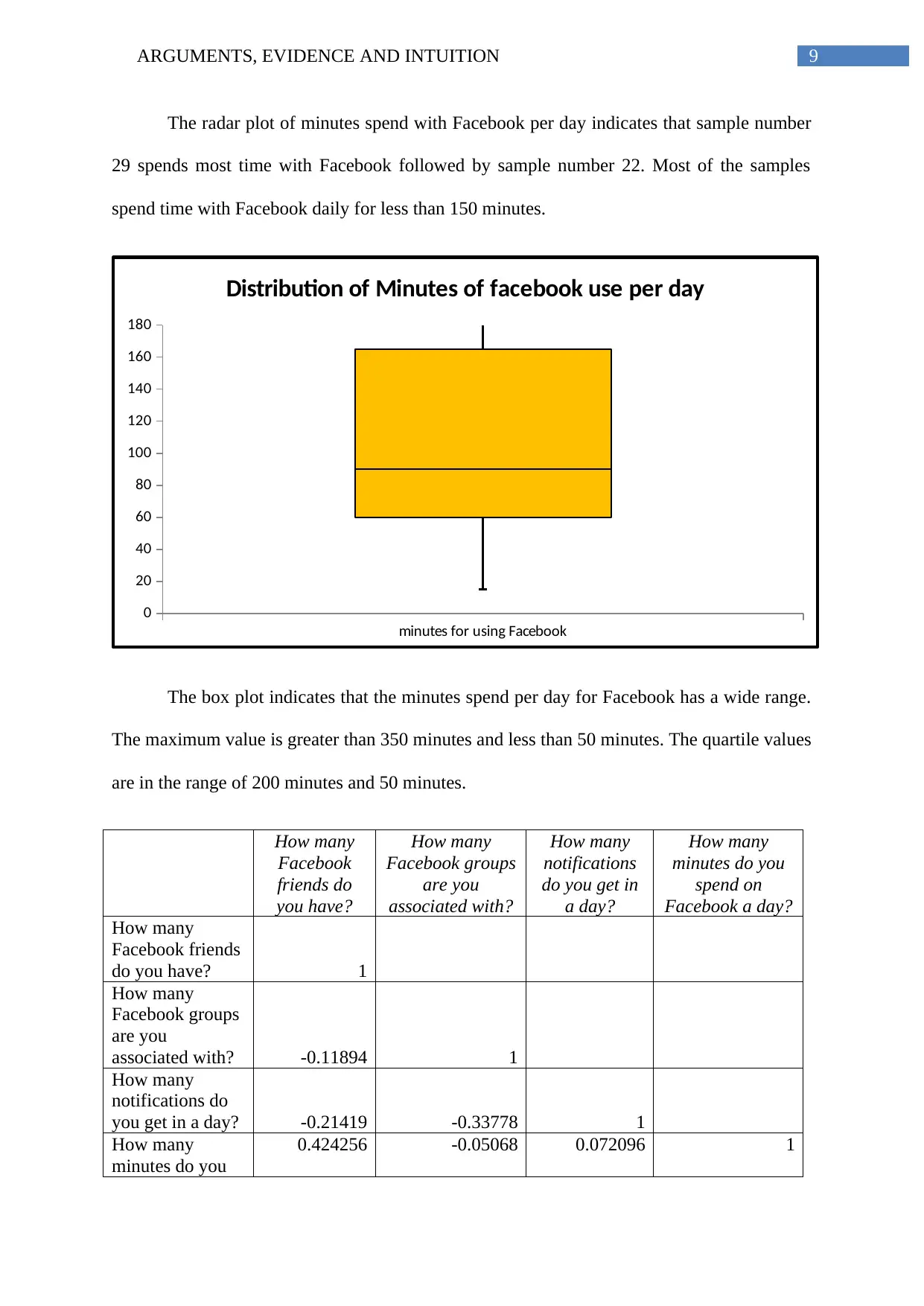
9ARGUMENTS, EVIDENCE AND INTUITION
The radar plot of minutes spend with Facebook per day indicates that sample number
29 spends most time with Facebook followed by sample number 22. Most of the samples
spend time with Facebook daily for less than 150 minutes.
minutes for using Facebook
0
20
40
60
80
100
120
140
160
180
Distribution of Minutes of facebook use per day
The box plot indicates that the minutes spend per day for Facebook has a wide range.
The maximum value is greater than 350 minutes and less than 50 minutes. The quartile values
are in the range of 200 minutes and 50 minutes.
How many
Facebook
friends do
you have?
How many
Facebook groups
are you
associated with?
How many
notifications
do you get in
a day?
How many
minutes do you
spend on
Facebook a day?
How many
Facebook friends
do you have? 1
How many
Facebook groups
are you
associated with? -0.11894 1
How many
notifications do
you get in a day? -0.21419 -0.33778 1
How many
minutes do you
0.424256 -0.05068 0.072096 1
The radar plot of minutes spend with Facebook per day indicates that sample number
29 spends most time with Facebook followed by sample number 22. Most of the samples
spend time with Facebook daily for less than 150 minutes.
minutes for using Facebook
0
20
40
60
80
100
120
140
160
180
Distribution of Minutes of facebook use per day
The box plot indicates that the minutes spend per day for Facebook has a wide range.
The maximum value is greater than 350 minutes and less than 50 minutes. The quartile values
are in the range of 200 minutes and 50 minutes.
How many
friends do
you have?
How many
Facebook groups
are you
associated with?
How many
notifications
do you get in
a day?
How many
minutes do you
spend on
Facebook a day?
How many
Facebook friends
do you have? 1
How many
Facebook groups
are you
associated with? -0.11894 1
How many
notifications do
you get in a day? -0.21419 -0.33778 1
How many
minutes do you
0.424256 -0.05068 0.072096 1
Paraphrase This Document
Need a fresh take? Get an instant paraphrase of this document with our AI Paraphraser
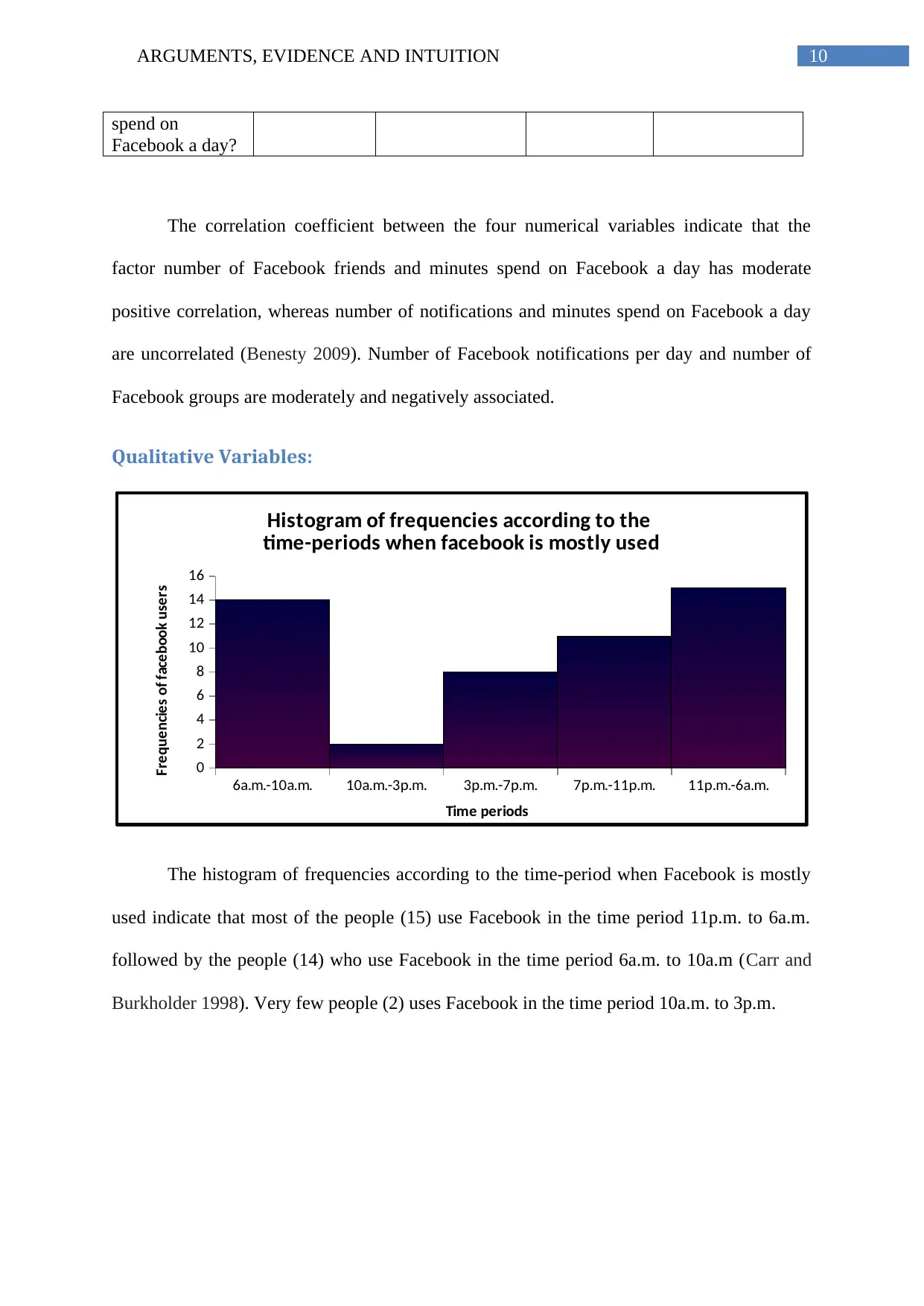
10ARGUMENTS, EVIDENCE AND INTUITION
spend on
Facebook a day?
The correlation coefficient between the four numerical variables indicate that the
factor number of Facebook friends and minutes spend on Facebook a day has moderate
positive correlation, whereas number of notifications and minutes spend on Facebook a day
are uncorrelated (Benesty 2009). Number of Facebook notifications per day and number of
Facebook groups are moderately and negatively associated.
Qualitative Variables:
6a.m.-10a.m. 10a.m.-3p.m. 3p.m.-7p.m. 7p.m.-11p.m. 11p.m.-6a.m.
0
2
4
6
8
10
12
14
16
Histogram of frequencies according to the
time-periods when facebook is mostly used
Time periods
Frequencies of facebook users
The histogram of frequencies according to the time-period when Facebook is mostly
used indicate that most of the people (15) use Facebook in the time period 11p.m. to 6a.m.
followed by the people (14) who use Facebook in the time period 6a.m. to 10a.m (Carr and
Burkholder 1998). Very few people (2) uses Facebook in the time period 10a.m. to 3p.m.
spend on
Facebook a day?
The correlation coefficient between the four numerical variables indicate that the
factor number of Facebook friends and minutes spend on Facebook a day has moderate
positive correlation, whereas number of notifications and minutes spend on Facebook a day
are uncorrelated (Benesty 2009). Number of Facebook notifications per day and number of
Facebook groups are moderately and negatively associated.
Qualitative Variables:
6a.m.-10a.m. 10a.m.-3p.m. 3p.m.-7p.m. 7p.m.-11p.m. 11p.m.-6a.m.
0
2
4
6
8
10
12
14
16
Histogram of frequencies according to the
time-periods when facebook is mostly used
Time periods
Frequencies of facebook users
The histogram of frequencies according to the time-period when Facebook is mostly
used indicate that most of the people (15) use Facebook in the time period 11p.m. to 6a.m.
followed by the people (14) who use Facebook in the time period 6a.m. to 10a.m (Carr and
Burkholder 1998). Very few people (2) uses Facebook in the time period 10a.m. to 3p.m.
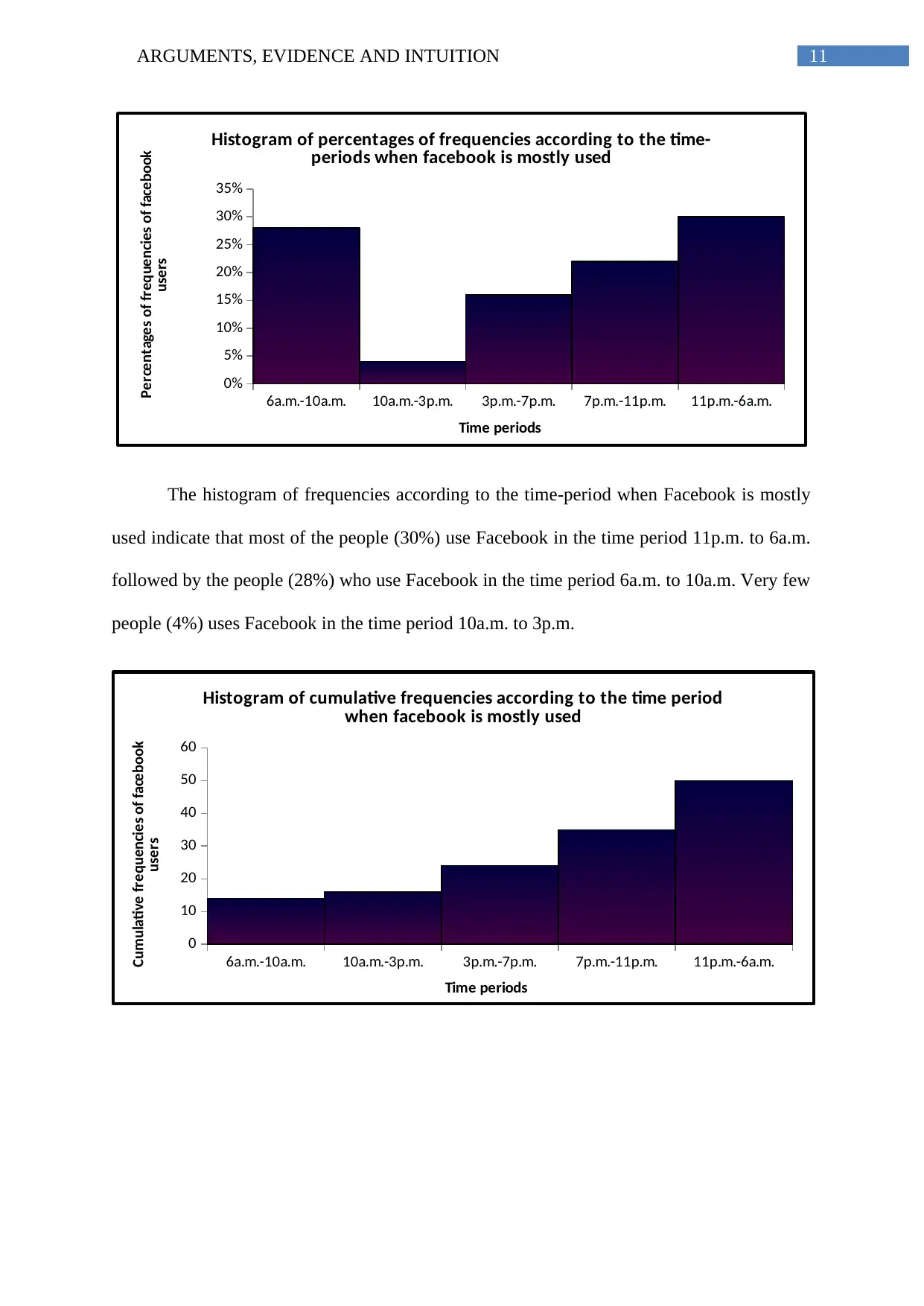
11ARGUMENTS, EVIDENCE AND INTUITION
6a.m.-10a.m. 10a.m.-3p.m. 3p.m.-7p.m. 7p.m.-11p.m. 11p.m.-6a.m.
0%
5%
10%
15%
20%
25%
30%
35%
Histogram of percentages of frequencies according to the time-
periods when facebook is mostly used
Time periods
Percentages of frequencies of facebook
users
The histogram of frequencies according to the time-period when Facebook is mostly
used indicate that most of the people (30%) use Facebook in the time period 11p.m. to 6a.m.
followed by the people (28%) who use Facebook in the time period 6a.m. to 10a.m. Very few
people (4%) uses Facebook in the time period 10a.m. to 3p.m.
6a.m.-10a.m. 10a.m.-3p.m. 3p.m.-7p.m. 7p.m.-11p.m. 11p.m.-6a.m.
0
10
20
30
40
50
60
Histogram of cumulative frequencies according to the time period
when facebook is mostly used
Time periods
Cumulative frequencies of facebook
users
6a.m.-10a.m. 10a.m.-3p.m. 3p.m.-7p.m. 7p.m.-11p.m. 11p.m.-6a.m.
0%
5%
10%
15%
20%
25%
30%
35%
Histogram of percentages of frequencies according to the time-
periods when facebook is mostly used
Time periods
Percentages of frequencies of facebook
users
The histogram of frequencies according to the time-period when Facebook is mostly
used indicate that most of the people (30%) use Facebook in the time period 11p.m. to 6a.m.
followed by the people (28%) who use Facebook in the time period 6a.m. to 10a.m. Very few
people (4%) uses Facebook in the time period 10a.m. to 3p.m.
6a.m.-10a.m. 10a.m.-3p.m. 3p.m.-7p.m. 7p.m.-11p.m. 11p.m.-6a.m.
0
10
20
30
40
50
60
Histogram of cumulative frequencies according to the time period
when facebook is mostly used
Time periods
Cumulative frequencies of facebook
users
⊘ This is a preview!⊘
Do you want full access?
Subscribe today to unlock all pages.

Trusted by 1+ million students worldwide
1 out of 16
Related Documents
Your All-in-One AI-Powered Toolkit for Academic Success.
+13062052269
info@desklib.com
Available 24*7 on WhatsApp / Email
![[object Object]](/_next/static/media/star-bottom.7253800d.svg)
Unlock your academic potential
Copyright © 2020–2025 A2Z Services. All Rights Reserved. Developed and managed by ZUCOL.





